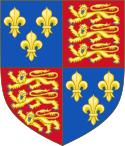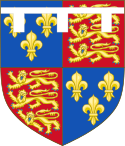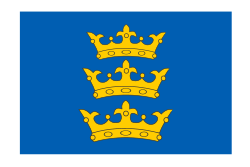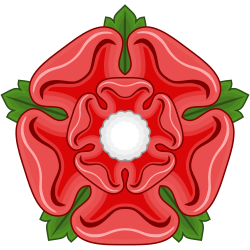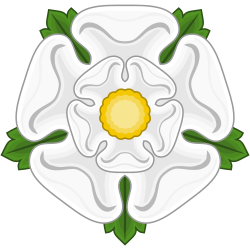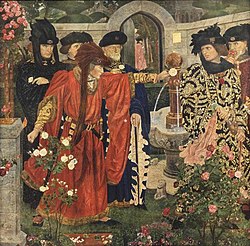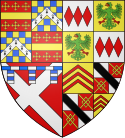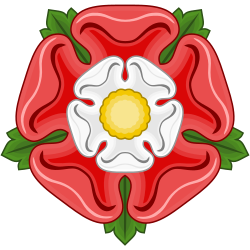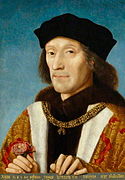Arms of Elizabeth Woodville
Elizabeth used a coat of arms of six quarters that of her father being relegated to the most junior position. Instead her noble and quasi-royal connections on her mother’s side were given prominence.
- 1:LUXEMBURG: Argent, a lion rampant double queued gules ducally crowned or (Limburg). Jacquetta’s father was a descendant of the Counts and Dukes of Limburg whose arms these are. The cadet branch of Luxemburg placed the red lion on a field of silver and blue bars. With the extinction of the senior line Count Peter’s branch assumed the original Limburg arms. At Queens’ College the lion is sometimes shown with only one tail and sometimes without the crown.
- 2: BAUX: Quarterly of 4:
- 1&4: Gules, a star of eight points argent (should be a star of sixteen points ?)
- 2&3: Azure semy de lis. Jacquetta’s mother was Margaret daughter of Francis of Baux Duke of Andria. The star is usually shown with straight arms, Queens’ sometimes shows it as an estoile (with wavy arms).
- 3: LUSIGNAN/CYPRUS: Barry of eight argent and azure, a lion rampant gules. The claim to the Kingdom of Cyprus is the most tenuous of all the Woodville quarterings. With the extinction of the legitimate line of the Kings of Cyprus the Republic of Venice had a plan to purchase the claims of Charlotte de Lusignan, Queen of Cyprus (1444-1487) (the eldest and only surviving daughter of King John II of Cyprus and Helena Palaiologina) and Catarina Cornaro, former Queens of Cyprus, and cede them to Anthony Woodville 2nd Earl Rivers the brother of Elizabeth. The plan came to nothing when Anthony died. These arms are very similar to those of the Counts of Luxemburg. The key differences being the lion has only one tail and (usually) no crown. The arms of Lusignan were originally Barry argent and gules (de Valence whose arms appear in those of Pembroke was a cadet branch) to this was added a lion rampant. According to Gelre’s Wapenboeck (1334-72) the lion was crowned.
- 4: URSINS / ORSINI: Bendy argent and gules, on a chief argent fimbriated in base or a rose gules barbed and seeded proper. Margaret of Baux (see above) was the daughter of Francis Duke of Andria and Sueva daughter of Nicolo Orsini Count of Nola. The Orsini (Ursins is a corruption of the name) were a powerful Roman family. The arms of Orsini are sometimes shown as gules three bends argent. In addition a green snake sometimes appears on the gold fillet under the rose.
- 5: ST POL: Gules, three pallets vair on a chief or a label of five points azure. Jacquetta’s great grandfather Guy I Count of Ligny married Mahaut de Chatillon daughter and heiress of John Count of St Pol. Guy became Count of St Pol jure uxoris. Marie daughter of Guy IV of Chatillon Count of St Pol d.1317 married Aymer of Valence Earl of Pembroke and founded Pembroke College, Cambridge, she was the aunt of John Count of St Pol. The versions of these arms in Queens’ are many and varied. Guy III of Chatillon was a younger son, his elder brother took the County of Blois whilst he became Count of St Pol, as such he differenced his arms by adding a label. The label is sometimes shown with 3 or 4 “points”.
- 6: WOODVILLE: Argent, a fess and canton conjoined gules. Sir Richard Wydeville (or Woodville) 1385-1441 was the Steward to the Duke of Bedford, Constable of the Tower of London and Captain of Calais. His son Sir Richard 1st Earl Rivers married Jacquetta of Luxemburg and was the father of Elizabeth the co-foundress of Queens’. The family were thought to be of lowly birth, far too lowly for a daughter to espouse a King. For this reason both the 1st Earl’s and Elizabeth’s coats of arms were aggrandised to make them appear nobler if not actually royal
Relevantní obrázky
Relevantní články
Války růžíVálky růží (1455–1487) byla série bitev občanské války v Anglii mezi spojenci rodů Lancasterů a Yorků. Příčiny konfliktu sahaly až k roku 1399, kdy přívrženci Lancasterů svrhli krále Richarda II. a ustavili novým králem Jindřicha IV. Po smrti jeho syna Jindřicha V. roku 1422 vládla zemi regentská rada místo nezletilého Jindřicha VI. Rozkrádání královského majetku regentskou radou a neúspěchy ve stoleté válce vedly Richarda Plantageneta z Yorku k mobilizaci vojenských sil proti královým rádcům. .. pokračovat ve čtení

